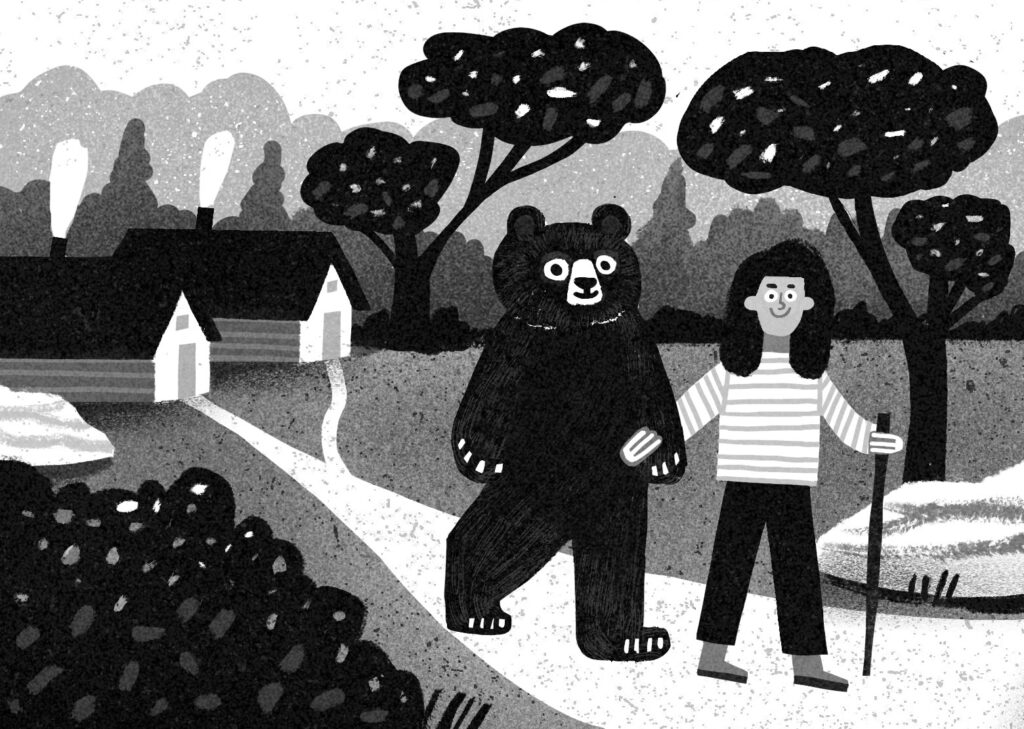Early in my first reading of Tammy Armstrong’s Pearly Everlasting, I found myself searching online for answers to questions like “Can bears be domesticated?” and “Do bears bond with humans?” I knew I was making a category error: Pearly Everlasting is a novel, after all. More than that, it is a novel imbued with a deep sense of mystery, particularly about bears — creatures, as one character observes, “of myth, of dreams and nightmares, of steel traps, and deep dens.” But Pearly Everlasting is also, Armstrong explains, inspired by a true story, that of William Lyman Underwood and his early twentieth-century memoir Wild Brother. Underwood visited a Maine lumber camp where he saw a woman “nursing her newborn daughter alongside an orphan bear cub.” The bear, known as Bruno, was placed in an animal sanctuary at age two. But Armstrong asks, What if he hadn’t been? What would it have been like for that baby girl, whom she names Pearly Everlasting, to grow up with Bruno as her brother?
Unsurprisingly, testing Armstrong’s tale of Pearly and Bruno against the facts about human-bear relationships undermines the novel’s plausibility: no, bears can’t be domesticated, and no, there is no evidence that they can form meaningful bonds with people, Underwood’s reported “lengthy friendship” with the original Bruno notwithstanding. These facts do not dictate a dead end for the novel, however; rather, they clarify that in spite of its veneer of realism — its rich and engrossing detail about the woods, the camp, and especially Bruno himself — we should read the book less literally, not as strictly allegorical but as deliberately and suggestively suspended between the real and the metaphorical.

A tale imbued with a deep sense of mystery and timely relevance.
Sandi Falconer
In Underwood’s place, Armstrong gives us Helen, known to Pearly as Song-catcher, a folklorist from the “Outside” who travels with her partner Ebony to the remotest logging camps of New Brunswick to chase down reports of “a woman who lived deep in the woods and suckled wild animals.” It’s a story that seems “more fairy tale than truth” until, stepping into a dark cabin in Camp 33, the women see “Mama’s slight form, and her bare breasts: an infant on her right and, on her left, just as the rumours claimed, a bear cub, who watched the women approach, though it did not stop its suck.”
Bruno, discovered orphaned in the woods by Pearly’s father, has found love and acceptance in the family and also in the camp, a place characterized by isolation, hardship, and loyalty: “All of us, with our bruised kindnesses and broken parts, looking out for each other because it was a matter of survival.” Then, when Pearly is nine, the camp gets a new boss, mean and swaggering Heeley O. Swicker, who hatches a plan to sell Bruno to a man who runs an animal show down in Boston. Initially, Swicker is unmoved by the family’s pleas —“That little bear’s my own heart,” exclaims Pearly’s mother, Eula, “and I’d no sooner sell him than I would one of my own children”— but when the logging crew also protests, he backs down. A few years later, Swicker is found dead in the woods; Bruno is the chief suspect, and he is captured and sent away. Sure of Bruno’s innocence, Pearly braves the Outside on a mission to bring him home.
Pearly encounters both helpers and hazards on her arduous quest. Most dramatically, a wild bear viciously attacks Bruno as they trek back toward the camp after she rescues him. Pearly drags her wounded brother to the town of Bracken, where Amaël Chanson, the local “animal doctor,” tends to his injuries. Amaël reminds us just how strange this whole story is: he sees Pearly and Bruno as “dispossessed” visitors from the mysterious woodland world “beyond his clinic’s door” and wonders how he will explain this “fairy tale encounter to his other, less imaginative neighbours.” With his support, Pearly begins making a place for herself in the town, but acceptance for the anomalous, perhaps unnatural siblings is harder won there than in Camp 33. Pearly knows they will have to leave when she becomes the target of a campaign of harassment by two young men who make tormenting her their “project.” Fearsome as the wild bear had been, Harold and Gerald are worse, as their violence is deliberately malicious in ways that provoke questions about what species is actually most threatening to women.
This is the kind of question that is really at the heart of Armstrong’s novel — not whether, say, a cub can safely share a bed with a toddler. Bruno may be written as if he’s an actual bear, but he is also a literary device to challenge our assumptions about kinship, about loyalty, about nature, and, above all, about what we are afraid of and why. The woods around Camp 33 are stalked by Jack in the Dark, a nightmarish phantom “touched by the devil.” But the Outside, as Pearly discovers, is stalked by people who lie, steal, bully, and beat — and by men who see women as their prey in ways, or for reasons, that bears never do.
Recently, the internet lit up after many women, polled on whether they would rather be trapped in the woods with a man or with a bear, responded that they would choose the latter. Those who scornfully reminded them how dangerous bears are were missing the point, just as my Google searches were the wrong approach to Pearly Everlasting, which deliberately blurs the line between fact and folklore. “Some might say a baby and a bear cub have no business living together,” Pearly acknowledges, “but I can assure you: seeing the world through our eyes might change your mind.”
Rohan Maitzen teaches English literature at Dalhousie University.

